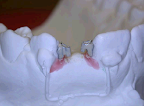Case presentation:

Patient L.R. 15y.o. after active treatment, agenesia of 22, space created for an implant on that region. The patient is in adolescence and the implant will be placed after growth has ceased completely at the age of 19-20. The temporary prosthetic rehabilitation of an agenesia space is an important issue especially in cases of lateral(s) missing
The retention protocol in such cases is extremely important. In this case this was achieved by a 0.9 SS wire in a Π configuration bonded on the buccal surface of 21,23 and as high vestibular as possible for less optic exposure and better aesthetics. The bonded acrylic crown has a secondary retention role but its main purpose is to offer an optimal temporary aesthetic result with no need for tooth substance removal.
This prosthetic solution has been recently developed in the Orthodontic department of Royal Dental school of Aarhus.







The bonded acrylic crown is an easy and cheap solution for the temporary aesthetic rehabilitation in an agenesia case. It should be noted though that it can not be considered a "functional" solution since it is not made to maintain the chewing function. It must kept in mind that the crown is bonded on the tooth surface in the same way the brackets are. Hence, its maintenance is questionable and very much dependent on patients overall function and care. So far, this technique is applied in only three patients in the Orthodontic clinic of Royal Dental school of Aarhus with promising short-term results. However, we don't yet know the long-term success rate of this technique.
Compared to a Maryland bridge, a bonded acrylic crown is far inferior from aesthetic, retentive and functional point of view. Nevertheless, its advantages can not be overlooked: a) there is no need for tooth substance removal, and b) it is a solution with a very low cost.
Hygiene:
Hygiene instruction are given to the patient upon the completion of the restoration. It is very important the patient to be able to maintain the health of the gum around the crown till the moment the implant is inserted. Demonstration of brushing and flossing the area is obligatory. For less food-plaque accumulation and easier cleaning the crown has been grinded palatally covering less gum surface and allowing for better hygiene.
"All photos and the case presented, are with the courtesy of my colleuge Photios Stavaras, DDS , and treatment was carried out at the orthodontic department of Aarhus Dental School, DK."

Patient L.R. 15y.o. after active treatment, agenesia of 22, space created for an implant on that region. The patient is in adolescence and the implant will be placed after growth has ceased completely at the age of 19-20. The temporary prosthetic rehabilitation of an agenesia space is an important issue especially in cases of lateral(s) missing
The retention protocol in such cases is extremely important. In this case this was achieved by a 0.9 SS wire in a Π configuration bonded on the buccal surface of 21,23 and as high vestibular as possible for less optic exposure and better aesthetics. The bonded acrylic crown has a secondary retention role but its main purpose is to offer an optimal temporary aesthetic result with no need for tooth substance removal.
This prosthetic solution has been recently developed in the Orthodontic department of Royal Dental school of Aarhus.
- Alginate impressions are taken and study casts are produced for the lab procedure that follows.
- The teeth that will be used as abutments for the crown (21,23) are covered with 2 layers of a separator material (eg. Aislar) and left for 2-3 hours.

- Two Begg brackets are bonded: one distally of 21 and another one mesially of 23. The bonding method is the same used for bonding brackets on real teeth.

- Begg Brackets are sandblasted, to increase the adhesion with the acrylic crown that will be fabricated

- Opek coating is applied on the brackets in order to increase the opacity of the acrylic and to reduce the black shade originated from the bracket metal on the mesio-distal side of the crown.


- The crown with the 2 Begg brackets incorporated mesio-distally is ready to be bonded.


- Final result.
The bonded acrylic crown is an easy and cheap solution for the temporary aesthetic rehabilitation in an agenesia case. It should be noted though that it can not be considered a "functional" solution since it is not made to maintain the chewing function. It must kept in mind that the crown is bonded on the tooth surface in the same way the brackets are. Hence, its maintenance is questionable and very much dependent on patients overall function and care. So far, this technique is applied in only three patients in the Orthodontic clinic of Royal Dental school of Aarhus with promising short-term results. However, we don't yet know the long-term success rate of this technique.
Compared to a Maryland bridge, a bonded acrylic crown is far inferior from aesthetic, retentive and functional point of view. Nevertheless, its advantages can not be overlooked: a) there is no need for tooth substance removal, and b) it is a solution with a very low cost.
Hygiene:
Hygiene instruction are given to the patient upon the completion of the restoration. It is very important the patient to be able to maintain the health of the gum around the crown till the moment the implant is inserted. Demonstration of brushing and flossing the area is obligatory. For less food-plaque accumulation and easier cleaning the crown has been grinded palatally covering less gum surface and allowing for better hygiene.
"All photos and the case presented, are with the courtesy of my colleuge Photios Stavaras, DDS , and treatment was carried out at the orthodontic department of Aarhus Dental School, DK."

No comments:
Post a Comment